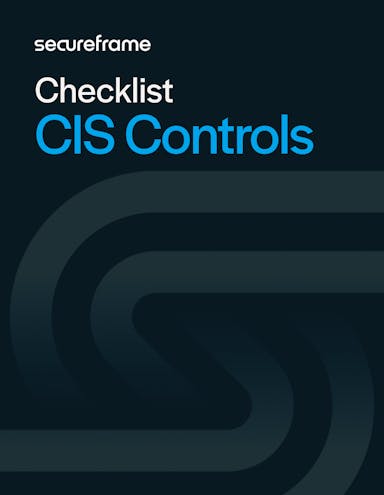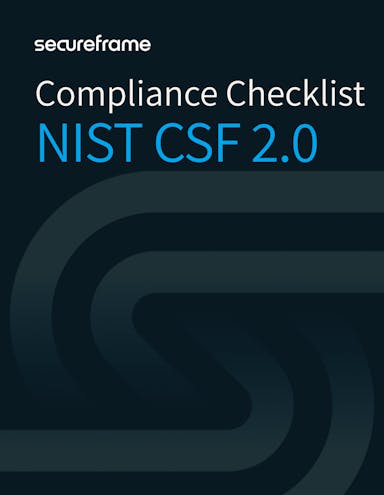
NIST vs CIS: How to Decide Which Cybersecurity Framework Is Right for You
Anna Fitzgerald
Senior Content Marketing Manager
Rob Gutierrez
Senior Cybersecurity and Compliance Manager, CISA, CCSK, CMMC RP
According to the World Economic Forum’s Global Cybersecurity Outlook 2025 report, 72% of executives reported a rise in cyber risks. Others noted that cybercrime not only grew in frequency but also sophistication due to generative AI and more complex supply chains.
As cyber threats increase in both frequency and sophistication, organizations need a structured way to defend against these evolving threats. But with so many cybersecurity frameworks available, deciding which to adopt can be overwhelming.
This guide compares two widely used frameworks: the NIST CSF and CIS Controls. We’ll break down what each framework is, compare their key features, and help you determine which is best for your organization.
NIST CSF: Quick Overview
The NIST Cybersecurity Framework (CSF) is a set of standards, guidelines, and best practices developed by the National Institute of Standards and Technology (NIST), a non-regulatory agency of the U.S. Department of Commerce.
Originally released in 2014 and significantly updated in February 2024, this framework is mandatory for federal contractors and government agencies but designed to help organizations of any sector, size, or maturity level manage cybersecurity risk.
CIS Controls: Quick Overview
The CIS Critical Security Controls® (CIS Controls®) are a set of 18 prioritized best practices developed by the Center for Internet Security (CIS). First introduced by the SANS Institute in 2008 and last updated in June 2024, the CIS Controls are designed to help organizations defend against the most common cyber attack vectors, including malware, ransomware, web application attacks, insider threats and misuse, and targeted intrusions, among others.
While the latest version, CIS Controls v8.1, was updated to align with NIST CSF 2.0, the CIS Controls are more prescriptive and actionable and can be a great starting point for any cybersecurity program.
Let’s take a closer look at the similarities and differences between these two widely used frameworks below.
NIST vs CIS: Key differences and similarities
Both the NIST and CIS frameworks share a similar purpose, but differ in terms of audience, structure, flexibility, and more.
The table below offers a high-level comparison of the frameworks. We’ll dive deeper into each factor so you can make a confident and informed decision about which one is right for your organization.
| Category | NIST CSF | CIS Controls |
|---|---|---|
| Purpose and design | Provide guidelines for improving management of common and unique cybersecurity risks | Prescribe foundational best practices for enhancing cybersecurity posture and mitigating the most common cyber risks |
| Best suited for | Anyone, but mandatory for U.S. federal agencies and contractors and recommended for critical infrastructure, commercial, and more mature organizations | Anyone, but especially SMBs, MSPs, and organizations with lower cybersecurity maturity looking to start and scale a cybersecurity program quickly and with limited resources |
| Level of flexibility | High (Provides outcomes that are sector-, country-, and technology-neutral and leaves the “how” up to the organization) |
Medium (Essentially prescribes a checklist of controls and technical safeguards, but organizations can take a tailored and prioritized approach to implementing them) |
| Structure | 6 Functions broken down into 22 categories and 106 subcategories that represent high-level cybersecurity outcomes | 18 prescriptive controls broken down into 153 safeguards (i.e., actionable tasks to implement the control) |
| Scalability | Organizations can use CSF Profiles and Tiers to help them tailor, assess, and prioritize the outcomes they want to achieve | Organizations can select 1 of 3 implementation groups to guide which Controls they implement and when |
| Ease of implementation | Relatively difficult (Requires tailoring activities including scoping your Organizational Profile, governance planning, and technical knowledge to determine how to achieve outcomes and when) |
Easy (More straightforward to implement because CIS Controls are easily digestible, actionable, and clearly prioritized in the different implementation groups) |
| Updates | First major update in February 2024 was v2.0 | Several updates over the years, with latest being v8.1 in June 2024 |
| Framework mappings and alignment | Aligns most closely with other frameworks designed for federal government and critical infrastructure, like NIST 800-171, NIST 800-53, and NIST SSDF | Aligns with broad range of industry frameworks, including PCI DSS, HIPAA, GDPR, SOC 2, and more |
Purpose and design
Both NIST CSF and CIS Controls are foundational frameworks with a similar purpose (to enhance risk management), but are designed in very different ways to achieve that purpose.
The purpose of NIST CSF is to help organizations understand and improve their management of cyber risks—not just the most common ones but also the risks that are unique to them based on their size, sector, and maturity level. To fulfill this purpose, the CSF does not prescribe what specific actions an organization must take to better understand, assess, prioritize, and communicate its cybersecurity efforts. Instead, it presents a set of desirable outcomes that can improve your cyber risk management and then links to online resources that provide security practices and controls that could be used to achieve those outcomes.
The CIS Controls have a similar purpose to NIST CSF: to manage cyber risk more effectively. The key difference is that the purpose of the CIS Controls is to help organizations identify, manage, and mitigate the most prevalent cyber threats against systems and networks. To achieve this purpose, the CIS Controls provide a prescriptive, prioritized, and simplified set of best practices which is inherently more comprehensive than NIST CSF. While these prescribed foundational security measures may not help your organization protect itself against the unique risks it faces, they can help improve your security posture.
Now let’s take a look at who typically uses NIST CSF vs CIS.
Audience and adoption
Both NIST CSF and CIS Controls are voluntary frameworks for many organizations (but not all). While designed for organizations of any size and sector, they are more commonly implemented by some.
The NIST CSF is most often used by U.S. federal agencies and defense contractors because compliance was mandated in 2017 by Executive Order 13800, Strengthening the Cybersecurity of Federal Networks and Critical Infrastructure. However, outside the public sector, many critical infrastructure companies and commercial organizations also adopt NIST CSF as a best-practice framework for risk management. In fact, the latest version, CSF 2.0, explicitly aims to help all organizations manage and reduce risks, rather than just those in the federal supply chain or critical infrastructure.
While completely voluntary, the CIS Controls are widely adopted by SMBs, enterprises with low cybersecurity maturity, and managed service providers (MSPs) who are looking to allocate resources efficiently, address the most significant risks first, and achieve meaningful security improvements over time for themselves or their clients. The CIS Controls are particularly well-suited for these types of organizations because they are designed to prioritize the most critical security actions to avoid overwhelming an organization with too many simultaneous tasks.
For this reason and because CIS publishes mappings to dozens of other frameworks, CIS Controls are an ideal foundation for a cybersecurity program. But for this same reason, they are generally less suitable for smaller organizations that have less resources and also more mature organizations that likely already have many of the prescribed foundational practices in place.
To better understand why these different types of organizations tend to implement one framework over the other, let’s take a closer look at their level of flexibility.
Level of flexibility
Because they are designed to be suitable for organizations of all sizes and industries, both the NIST CSF and CIS Controls are flexible frameworks—to different degrees.
The NIST CSF is highly flexible and adaptable because it does not specify exact controls or actions organizations must take. Instead, it provides a high-level framework that organizations can tailor to their unique cybersecurity needs, risk profiles, and regulatory requirements. This flexibility makes it a strong fit for organizations of many different sizes, industries, geographies, tech stacks, and maturity levels. But this flexibility also means implementation can be harder, which makes it less ideal for certain organizations. We’ll discuss this more in a later section.
The CIS Controls are less flexible by design because they try to strike a balance between being comprehensive enough to protect and defend against the most common cyber threats regardless of organization size or industry, but also prescriptive enough to ease implementation. The latest version (8.1) prescribes a set of controls and safeguards that cover essential areas such as data protection, access control management, and incident response in order to provide a holistic but simplified approach to cybersecurity.
Organizations can prioritize and implement these controls and safeguards based on their risk profile and available resources, which offers some customizability. Still, this framework can feel too rigid or limited for organizations with unique business models, higher levels of security maturity, or in highly regulated environments that require broader coverage.
Before we take a closer look at how these frameworks compare in terms of ease of implementation, we have to understand how these two frameworks are structured.
Structure and components
Both NIST CSF and CIS Controls have hierarchical structures, but look very different.
The NIST Cybersecurity Framework (CSF) is organized into six high-level functions: Govern, Identify, Protect, Detect, Respond, and Recover. Within each function are categories (22 in total) and subcategories (106 in total) that define each cybersecurity outcome. For example, the Identify Function includes categories like Asset Management and Risk Assessment whereas the Respond Function includes categories like Incident Management and Incident Analysis. Together, these outcomes, categories, and categories make up the CSF Core (or Appendix A). The Core is not a prescriptive checklist, but a set of flexible goals organizations can adapt to their unique environments.
NIST CSF links to supporting resources like Quick Start Guides, Implementation Examples, and references to other standards such as NIST 800-53. These provide additional guidance on practices and controls that may be used to achieve those outcomes, but aren’t required to.
The CIS Critical Security Controls, by contrast, are much more prescriptive. The latest version of the framework consists of 18 Controls broken down into 153 Safeguards. Each is tied to one of six asset classes (Devices, Software, Data, Users, Networks, Documentation) and one of the six NIST CSF Functions. However, unlike the categories and subcategories in CSF which detail each outcome, the CIS Safeguards describe specific and actionable steps that an organization can take to fully implement each of the 18 Controls, such as establishing and maintaining a detailed enterprise asset inventory.
Before we compare these frameworks in terms of ease of implementation, we must also understand how they are designed to help organizations prioritize and scale their efforts over time.
Scalability
Both frameworks are designed to be scalable but offer different mechanisms to help organizations understand, assess, and prioritize the actions they need to take to improve risk management.
NIST CSF introduces the concepts of CSF Profiles and Tiers. A CSF Organizational Profile describes an organization’s current and/or target cybersecurity posture in terms of the CSF outcomes so that it can prioritize its efforts to achieve specific outcomes and communicate that plan to stakeholders.
The CSF defines four tiers to help inform the Organizational Profile. These tiers describe the sophistication of an organization’s cybersecurity governance and management:
- Partial
- Risk-Informed
- Repeatable
- Adaptive
For example, a Tier 1 organization may have informal or ad hoc practices and a Tier 4 organization with integrated, adaptive processes informed by lessons learned and threat intelligence. The tiers aren’t maturity levels, but they provide a flexible way for organizations to assess and improve their cyber risk posture over time if their risk profile or security requirements increase or if they can do so cost-effectively.
Whether first implementing NIST CSF or scaling their efforts over time, organizations should select the tier that meets their organizational goals and reduces cybersecurity risk to an acceptable level but is also feasible for them to implement.
CIS Controls, meanwhile, use Implementation Groups (IGs) as their mechanism for prioritization and scaling. Each of the three IGs identifies a subset of Controls and Safeguards that the organization must implement, which makes it easy for organizations to prioritize what to implement and when. The three groups are based on size, resources, and risk:
- IG1 provides basic cyber hygiene for SMBs with limited resources
- IG2 is designed for organizations with more complexity, sensitive data, and dedicated IT/security staff
- IG3 is meant for large enterprises facing advanced threats that have mature cybersecurity capabilities and specialized expertise
Recommended reading

How to Build a Compliance Program that Meets Your Business Expansion Goals
Ease of implementation
Adopting NIST CSF often requires more substantial work upfront than implementing the CIS Controls. Organizations need to:
- select and prioritize the CSF outcomes it wants to achieve first
- map their existing processes and controls to these outcomes
- identify gaps, and
- design an action plan to achieve these outcomes (or to achieve them more fully)
This action plan must align with the organization’s mission objectives, stakeholder expectations, threat landscape, and requirements and delineate what controls and practices from various related standards, guidelines, regulations, and other content—collectively referred to as Informative References—it will implement.
Larger, more mature enterprises benefit from this highly customizable and non-prescriptive approach to implementation. For smaller teams and less mature organizations, the lack of prescriptive “how-to” steps can make implementation daunting without expert support or automation tools.
By contrast, the CIS Controls are designed to be straightforward to implement. With clearly defined Safeguards and Implementation Groups, even small IT teams can quickly identify what to do first. CIS Controls are also frequently referenced by state regulators as an example of “reasonable security,” giving organizations a practical way to demonstrate compliance with minimal overhead. Additionally, the CIS controls have a lot of overlap with NIST 800-53, so adopting CIS can be easier if NIST 800-53 is already implemented.
Now let’s take a closer look at how these frameworks have evolved over time to ensure they remain applicable, actionable, and scalable.
Recommended reading

Why Compliance Automation is a Strategic Advantage for Modern Organizations
Updates
Both NIST CSF and CIS Controls are updated continuously to keep up with evolving cyber risks and technologies and ensure each framework remains relevant and readily accessible by organizations of all sizes and sectors.
The most recent version of the NIST CSF (2.0), released in February 2024, was its first major update in a decade. It expanded its scope beyond critical infrastructure to all organizations, added a stronger focus on governance and supply chain risk management, and refined its functions and categories to reflect today’s threat landscape. It also added Implementation Examples and Informative References to help smaller organizations as well as their larger counterparts understand potential ways to achieve each CSF outcome.
CIS has introduced several updates to the CIS Controls over the years to address emerging technologies and threats and ensure organizations have the most up-to-date and effective defenses to stop the threats and attacks they are observing. Other significant changes have been made to simplify the implementation and prioritization of its security measures, like the introduction of Implementation Groups in version 7.1.
The latest version of the CIS Controls v8.1, released in June 2024, introduced Documentation as a new asset class, expanded glossary definitions, and added Governance as a security function to more closely match all parts of an enterprise's infrastructure to which the Safeguards apply and align with NIST CSF 2.0.
Now let’s take a closer look at how these two frameworks align with each other and other frameworks.
Recommended reading

A Guide to Regulatory Change Management & How Software Can Simplify It
Mapping and alignment to other frameworks
Both NIST CSF and the CIS Controls are related and mapped to various standards, guidelines, frameworks, regulations, and policies—including each other. This means that implementing one of these frameworks can help you meet requirements in other information security frameworks, helping to reduce duplicate work and speed up time-to-compliance as you scale your compliance program over time.
While both frameworks can be mapped to dozens of frameworks, a key difference is that NIST CSF is aligned most closely with federal and critical infrastructure frameworks and CIS is aligned with a broader range of industry frameworks.
The NIST Informative Reference Catalog shows how the latest version of NIST CSF is mapped to and referenced by frameworks including but not limited to:
- NIST 800-171
- NIST 800-53
- NIST 800-37 Risk Management Frameowrk
- NIST SP 800-66r2: Implementing the Health Insurance Portability and Accountability Act HIPAA) Security Rule
- ISO 27001
- Cybersecurity Capability Maturity Model (C2M2)
- Secure Controls Framework (SCF)
- NICE Framework
- CSA Cloud Controls Matrix
- IoT Security Maturity Model: Practitioner’s Guide v1.2
- NIST Special Publication 800-218, Secure Software Development Framework (SSDF)
The CIS Critical Security Controls Navigator shows how the CIS Controls are mapped to and referenced by multiple legal, regulatory, and policy frameworks, including but not limited to:
- Azure Security Benchmark
- CMMC v2.0
- Criminal Justice Information Services (CJIS)
- CSA Cloud Controls Matrix
- Cyber Essentials v2.2
- HIPAA
- ISACA COBIT 19
- ISO/IEC 27002:2002
- MITRE Enterprise ATT&CK v8.2
- NIST 800-171
- NIST 800-53
- NYDFS Part 500
- PCI DSS v4.0
- SOC 2
Recommended reading

Control Mapping: What It Is & How It Can Help Simplify Your Compliance Efforts
When to pick NIST vs CIS framework
The choice between NIST and CIS depends on your business goals, risk profile, and regulatory environment.
As a general rule of thumb, choose NIST CSF if you:
- Operate in highly regulated industries or federal supply chains
- Need a cybersecurity framework that can be tailored to your unique data and risk environment
- Want a highly flexible framework that can map to multiple control sets
- Have some security and compliance expertise
- Have a mature compliance and cybersecurity posture
Choose CIS Controls if you:
- Are an SMB or MSP looking for actionable, prioritized, and prescriptive security guidance
- Want to demonstrate “reasonable security” under state laws
- Need a solid foundation to improve cyber hygiene quickly and then scale your compliance program over time
- Have less resources available

Many organizations use both frameworks together, leveraging NIST CSF for high-level outcomes and strategy and CIS Controls for tactical implementation to achieve those outcomes and strategy.
Recommended reading

The Ultimate Guide to Managing Multi-Framework Compliance
NIST vs CIS: Compare tasks side by side with free checklists
Understanding how NIST CSF and CIS Controls compare in theory is important— but the real differences can become clearer when you look at the specific measures and tasks each framework requires.
Download our free NIST CSF 2.0 Checklist and CIS Compliance Checklist to see how the frameworks stack up in practice:
- Breadth: NIST covers six high-level cybersecurity functions, while CIS focuses on a broader set of foundational cybersecurity measures.
- Control language: NIST CSF provides flexible outcomes, while CIS prescribes specific safeguards.
- Flexibility and ease of implementation: NIST requires tailoring and mapping, while CIS offers step-by-step but more rigid guidance.
- Language: NIST uses broad, outcome-oriented language; CIS uses direct, actionable phrasing.
Download the checklists to review them side by side. This can give your team a new lens for comparing these frameworks and help you choose the one that best matches your risk profile, regulatory requirements, and available resources.

CIS Controls Implementation Checklist
Follow this structured approach to begin implementing all 18 Controls in CIS Controls v8.1, ensuring that your organization covers essential areas of cybersecurity.

NIST CSF 2.0 Compliance Checklist
Use this checklist to identify, prioritize, and organize actions under the six functions of NIST CSF 2.0 and track progress towards compliance.
Simplifying NIST CSF, CIS, or multi-framework adoption with Secureframe
Both NIST CSF and CIS Controls can strengthen your cybersecurity posture, but implementing them manually can be resource-intensive. That’s where Secureframe helps.
With Secureframe, you can:
- Automate evidence collection and policy management
- Map controls across frameworks, including NIST CSF, CIS Controls, ISO 27001, NIST 800-53, and more
- Continuously monitor your tech stack for compliance gaps
- Simplify vendor and employee management
- Stay current with framework updates like NIST CSF 2.0 and CIS v8.1
Whether you’re adopting CIS Controls, NIST CSF, or both, Secureframe’s automation platform can help you save time, reduce costs, and build and scale a robust compliance program—schedule a demo to learn how.
FAQs
What is the difference between CIS vs NIST?
NIST CSF is a high-level, flexible framework for improving your organization’s understanding and management of common and unique cyber risks, whereas CIS Controls are a prescriptive, prioritized set of safeguards for defending against the most common cyber risks.
Are there different assessment requirements for CIS vs NIST?
No. Neither framework offers certification or requires audits, but both emphasize continuous monitoring, measurement, and improvement of security practices. Whether implementing NIST CSF or the CIS Controls, organizations should conduct readiness assessments internally or hire a consultant to evaluate their practices for managing cybersecurity risk and identify areas for improvement on a regular basis.
Are CIS Controls mapped to NIST 800-53?
Yes, CIS Controls map to the NIST 800-53 Low and Moderate Baselines. For example, the CIS Control 1.1 Establish and Maintain Detailed Enterprise Asset Inventory maps to the following NIST 800-53 controls:
- CM-8
- CM-8(1)
- PM-5
- CM-8(3)
To view the complete mappings of the CIS Controls v8.1 and CIS Safeguards to NIST SP 800-53 Rev 5, download this document from the CIS website.
Should I implement CIS vs NIST vs ISO?
It depends. Here’s some reasons you might implement each framework:
- You’re an SMB or MSP looking to improve cybersecurity fast with limited resources → CIS
- You’re part of the federal supply chain → NIST CSF
- You’re looking to get certified to provide third-party assurance to global customers → ISO 27001
Use trust to accelerate growth

Anna Fitzgerald
Senior Content Marketing Manager
Anna Fitzgerald is a digital and product marketing professional with nearly a decade of experience delivering high-quality content across highly regulated and technical industries, including healthcare, web development, and cybersecurity compliance. At Secureframe, she specializes in translating complex regulatory frameworks—such as CMMC, FedRAMP, NIST, and SOC 2—into practical resources that help organizations of all sizes and maturity levels meet evolving compliance requirements and improve their overall risk management strategy.

Rob Gutierrez
Senior Cybersecurity and Compliance Manager, CISA, CCSK, CMMC RP
Rob Gutierrez is an information security leader with nearly a decade of experience in GRC, IT audit, cybersecurity, FedRAMP, cloud, and supply chain assessments. As a former auditor and security consultant, Rob performed and managed CMMC, FedRAMP, FISMA, and other security and regulatory audits. At Secureframe, he’s helped hundreds of customers achieve compliance with federal and commercial frameworks, including NIST 800-171, NIST 800-53, FedRAMP, CMMC, SOC 2, and ISO 27001.